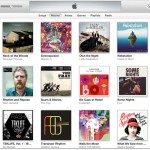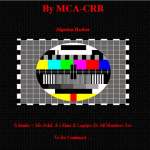The Secret To Iranian Drone Technology? Just Add Photoshop
garymortimer writes "Earlier this month, Iran's news agency provided visual evidence that its government had figured out to make a fancy new drone that could take off and land vertically. What they didn't tell us is that they used Photoshop to make it stop taking off from the roof of Japan's Chiba University, which built the aircraft and never had anything to do with Iran's alleged version of it." Read more of this story at Slashdot.
New Apple iTunes 11 interface revealed
Vintage ad scanned and Flickr'd by James Vaughan . Wouldn't it be nifty if the newest iteration of iTunes , which in my opinion is one of a great company's poorest products, looked like this? The Ping-less iTunes 11 is set to launch this month, likely today, according to hints dropped in this Wall Street Journal profile of Apple exec Eddy Cue. It's not that big a secret, anyways; the Apple.com iTunes splash page says it's "coming in November," and there aren't many days left in November. Below, *actual* screenshots of the new interface. Come to think of it, the new UI resembles the vintage ad more than iTunes 10 does! But I don't like it. I wish iTunes were a skinnable, interpret-able service with an API, like Twitter is (for now, anyway)—imagine if you could use any third-party client you wanted to access the service, as cleanly and free of cruft as you please. Library view Album view
Japan unveils prototype of new maglev train, promises speeds of up to 311 mph
More than a year after the Central Japan Railway Company (JR Tokai) received construction approval to get going on its maglev railways, it has finally unveiled a Series L0 prototype that would put its current bullet train system to shame. Designed to travel at 311 mph, a single one of these high-speed marvels is designed to carry about 16 carriages, which translates to about 1,000 commuters. While Japanese travelers already enjoy a speedy 90-minute trip from Tokyo to Nagoya, this new maglev system promises to cut that journey to just 40 minutes. Announced nearly five years ago , the project has since been extended to include an Osaka-Tokyo leg and will cost around nine trillion yen (approximately $112 billion) when all is said and done. Don't pack your bags just yet though; the maglev's Nagoya rail isn't scheduled to go live until 2027, and the boarding call for Osaka isn't until 2045. Of course, if you need to ride electromagnetic rails now , there's always China's Shanghai Transrapid, which has been ferrying passengers to and fro the Pudong airport since 2004 -- it once reached speeds of 501km/h (311mph). China's even planning a whopping 1,000 km/h vacuum-tube maglev train in just a year or so. Of course, those of us on the other end of the Pacific are still waiting for that long-delayed California-Nevada maglev project to work out. Sigh. Filed under: Transportation Comments Via: Inhabitat Source: Phys.org
Amazon Web Services slices S3 prices
"We're lowering prices for S3 by 24 percent to 27 percent in all regions," says Andy Jassy, senior VP of Amazon Web Services; he also knocks old-guard tech rivals. [Read more]
Windows Blue: Microsoft’s Plan To Release a New Version of Windows Every Year
MrSeb writes "Way back in August, three months before the release of Windows 8, we learned about the existence of a project at Microsoft codenamed Blue. At the time it wasn't clear whether this was Windows 9, or some kind of interim update/service pack for Windows 8. Now, if unnamed sources are to be believed, Windows Blue is both of those things: a major update to Windows 8, and also the beginning of a major shift that will result in a major release of Windows every 12 months — just like Apple's OS X. According to these insiders, Blue will roll out mid-2013, and will be very cheap — or possibly even free, to ensure that 'Windows Blue the next OS that everyone installs.' Exact details are still rather vague, but at the very least Blue will make 'UI changes' to Windows 8. The sources also indicate that the Windows 8 and Windows Phone 8 SDKs will be merged or standardized, to further simplify the development of cross-platform apps. Perhaps more important, though, is the shift to a 12-month release cadence. Historically, Microsoft has released a major version of Windows every few years, with the intervening periods populated with stability- and security-oriented service packs. Now it seems that Microsoft wants to move to an OS X-like system, where new and exciting features will be added on an annual basis. In turn, Microsoft will drop the price of these releases — probably to around $25, just like OS X." Read more of this story at Slashdot.
Google, Microsoft, PayPal, other Romanian sites hijacked by DNS hackers
For a brief time, people trying to visit google.ro on Wednesday were connected to this page instead. Kaspersky Labs Romanian websites for Google, Microsoft, Yahoo, PayPal, and other operators were briefly redirected to a rogue server on Wednesday. The redirect is most likely a result of a decade-old hacking technique that underscores the fragility of the Internet's routing system. For a span of one to several hours on Wednesday morning, people typing Google.ro , Yahoo.ro , and Romanian-specific addresses for other sites connected to a website that was purportedly run by an Algerian hacker, according to numerous security blog posts, including this one from Kaspersky Lab. Researchers said the most likely explanation for the redirection is a technique known as DNS poisoning, in which domain name system routing tables are tampered with, causing domain names to resolve to incorrect IP addresses. DNS poisoning first came to light in the mid-1990s when researchers discovered that attackers could inject spoofed IP addresses into the DNS resolvers belonging to Internet service providers and large organizations. The servers would store the incorrect information for hours or days at a time, allowing the attack to send large numbers of end users to websites that install malware or masquerade as banks or other trusted destinations. Over the years, DNS server software has been updated to make it more resistant to the hack, most recently in 2008, when numerous providers introduced fixes to patch a DNS cache poisoning vulnerability discovered by researcher Dan Kaminsky. Read 3 remaining paragraphs | Comments
Photoshop Touch Now Works With Styluses
Photoshop Touch —Adobe's mobile image editor—just got a pretty stellar update . It's now sensitive to styluses on the iPad. More »
Court Demands Samsung Pay Apple $120,000 per Day
Must be an uncomfortable moment over at Samsung headquarters right now. Just weeks after mobile division head J.K. Shin talked some seriously big game , a court in the Netherlands granted one more point to Apple in the companies' ongoing patent lawsuits. More »
Pro-Iranian hackers stole data from UN atomic agency’s server
The United Nations' International Atomic Energy Agency has admitted that data from a retired server at its Vienna headquarters was stolen and posted to a hacker website. A group calling itself Parastoo allegedly stole the data in an effort to draw attention to Israel's nuclear weapons program and as a protest against attacks on Iran's nuclear efforts—including the use of the Stuxnet worm and assassinations of Iranian nuclear researchers. A Pastebin posting on November 25 by someone purporting to represent the group (which takes its name from the Farsi name for the swallow) listed the e-mail addresses of physicists and other experts that had consulted with the IAEA. The message urged the people whose addresses were listed to petition the IAEA to investigate "activities at Dimona"—the site of Israel's Negev Nuclear Research Center, which is widely believed to be the center of Israel's nuclear weapons production efforts. "We would like to assert that we have evidences [sic] showing there are beyond-harmful operations taking place at this site and the above list who technically help IAEA could be considered a partner in crime should an accident happen there," the statement read. Read 2 remaining paragraphs | Comments
A Sneak Peek At the Mind-Boggling Future of Computer Graphics
Computer graphics have come a long way since a T-Rex ate that lawyer in Jurassic Park . But if these glimpses of what the next generation of CG has in store, we ain't seen nothing yet. Cloth simulations with hyper-realistic wrinkling, modelling complex human hair using thermal imaging, and new approaches to smoke rendering will make our future blockbusters even more blockbustery. More »














